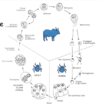Protozoa - coccidia related Flashcards
(39 cards)
Blood protozoa
Babesia
Theileria
Plamodium
Common hosts of Babesia
Dogs, cattle, small ruminants, horses, pigs, cats
IH of Babesia
Tick
Babesia lifecycle features
Infect host erythrocytes -> form trophozoites which divide by schizogony and become merozoites -> cell rupture -> infect new cells
transmission is theough ticks. When the parasite is within the tick they migrate through it and then undergo sporogony. They can undergo trans-ovarian transmission and infect tick eggs.
- eventually hundreds of sporozoitesare formed within the salivary cells and are injected into a new mammal host.
Causes of Babesiosis in dogs in Aus
B. vogeli
B. gibsoni
Features of B. vogeli
transmission
Pathogenesis
- transmitted by brown dog tick
- > pyrexia, icterus, splenomegaly, haemoglobinuria
pups 3-4 months and naive adults
Features of B. gibsoni
Transmission
Path
Haemaphysalis longicornis
- pyrexia, icterus, splenomegaly, haemoglobinuria
Direct transmission (fighting) and vertical (dam to pup)
Causes of Babesiosis in cattle
B. bovie
B. bigemina
Babesiosis in cattle other name?
Tick / Red Water Fever
Vector of cattle Babesia
Rhipicephalus australis
Pathogenesis of babesiosis in cattle
Subclinical
- weight loss, decreased milk production
- poor calving rates, loss of bull fertility
Acute:
- fever, abortion, Ill-thrift, pale mm, jaundice, haemoglobulinuria, agression / neurological signs, coagulopathy, death
Host resistance
- good protective immunity in persistant infections
Bos indicus is more resistant than Bos taurus
young cattle more resistant
Diagnosis of Babesiosis
History (season / geography)
- blood smears
- detection of intraerythrocytic stages
- Serology
- PCR
Babesiosis treatment
Supportive care - blood transfusion ,iron and Vitamin B12
Anti protozoal agents
Imidocarb dipropionate (SC/IM injection)
Diminazine aceturate
- anti tick vaccine
- tick control
- relapse common in dogs with B. gibsoni
Theileria significance
No pathogenic species in Aus
- Important in America, southern Europe and Africa
- Transmitted by ixodid ticks
Theileria Lifecycle
2 schizogony phases
- Leukocytes, lymphoid tissue
- macro and microschizonts - Erythrocytese
- Merozoites from microschizonts
- piroplasms in RBCs
- Tick ingests RBCs - gametogony / sex in tick gut

Clinical signs of Theileriosis
Fever - lymphadenopathy
-> haemolytic anaemia, lymph node swelling, pneumonia, jaundice, abortions, still births, metritis and mortality.
Calves more resistant to disease.
Develop a good immunity
Diagnosis of Theileria
Characteristic stages in erythrocytes on a Giemsa stained blood smear or schizonts in leukocytes, macrophages or tissue smears.
Treatment of Theileria
Buparaquone
primaquine - not registered in Aus.
In Ays can use Imidocarb
Halofuginone 10x dose
erythromycin in calves
What causes malaria?
Plasmodium
Where is Malaria an issue?
Endemic in PNG and SE Asia (not Aus anymore)
What species does Malraia affect?
- humans >1mill deaths per year
- birds, primates, reptiles and rodents
Lifecycle of Plasmodium
DH
IH
DH = mosquito - Anopheles spp
IH = vertebrate
Sporozoites undergo asexual schizogony in liver cells (some form hypnozoites here) -> merozoites then invade erythrocytes andergo more schizogony -> gametogony to for macro- and micro-gametocytes -> mosquito -> fusion of gametocytes -> ookinete 0> haemocoel -> oocyst -> hundreds of sporozoites -> salivary glands (mosquito is infected for life) -> infects a new host

Pathogenesis of Plasmodium in 1st schizogony phase
- hepatocytes
Hepatosplenomegaly
-leukopenia, thrombocytopenia
Hypnozoites -> relapsing fever


